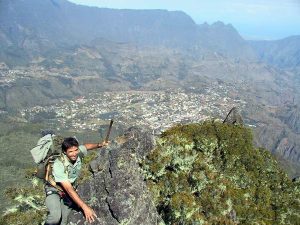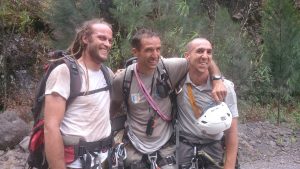Focus on a long-term partner : ONCFS/BNOI
Created in 1994 and placed under the coordination of the Réunion’s Directorate for Environment, Development and Housing, the Indian Ocean Nature Brigade (BNOI) is a team of environmental inspectors working all over the island. Unique in France, this brigade is multi-institutional. The agents belong to the National agency for Hunting and Wildlife (ONCFS), the French Agency for Biodiversity (AFB) and Réunion National Park.
This mixed service for environmental police handles the following missions:
- The surveillance, prevention and recording offences related to hunting and fishing
- The protection of species and protected areas, both on land and sea;
- The study of some specific species either endangered, endemic of invasive.
Even though the BNOI’s main activity is environmental police, to which it dedicates 60% of its time, it doesn’t neglect the technical studies led on endangered species.
Thus, for more than 15 years, the BNOI/ONCFS contribute to the preservation of Réunion’s endemic petrels. In 2001, its agents, along with Cilaos’ gendarmes, discovered a second breeding colony of Barau’s petrels.
Its expertise is today an undeniable asset for the project LIFE+ Pétrels, both technically and decision wise.
Its agents participates to exploration missions and both the Mascarene and Barau’s petrels colonies monitoring. Their knowledge of the field and of the species as well as their particular skillset in ropes, mooring, splicing and securing is utterly valuable since they allow the LIFE+ Pétrels team to work on perilous terrains in safe conditions. Moreover, their environmental police competences are appreciated in case an offence is noted. Last but not least, the BNOI is an active stakeholder of the National Plan of Actions (PNA) concerning the Mascarene Petrel as well as the LIFE+ Pétrels project. They help define strategic decisions and the global approach of the project.
————————————————————————————————————————————————————————————————
3 questions asked to Patxi Souharce, environmental inspector at the BNOI since 1994:
- The LIFE+ Pétrels program is funded by the European Union on a period ranging from 2014 to 2020. It is exclusively dedicated to the preservation of 2 endemic species of petrels. You have been involved in this thematics for 15 years now. What has this program changed regarding the management or the involvement of the ONCFS/BNOI?
L’ONCFS/BNOI has always participated in petrel conservation actions. We always were largely involved in them. But, before the LIFE+ Pétrels, it was us who, along with the SEOR and the Réunion University, were in charge of the logistical organisation and who implemented all the field actions (land-based and aerial). The LIFE relieve the BNOI team by taking over the organisation and management of the missions, which is time consuming. It allows us to concentrate only on the technical aspects.
- What was for dearest memory on the field with the LIFE?
I had the chance to be part of the missions that discovered the first breeding burrows of both the Barau’s petrel and the Mascarene petrel.
The Barau’s petrel were found by accident. In 2001, 2 gendarmes were searching for an old trail to climb the Piton des Neiges when they stumbled upon an area filled with bird carcasses. Not knowing which bird it was, they contacted the BNOI. Rapidly after that was assembled a team made of members of the ONCFS/BNOI, the ONF, the SEOR as well as members of the mission dedicated to the creation of Réunion’s National Park. They went on a reconnaissance mission and confirmed the presence of a breeding colony. After that, the agents hiked to the colony once each year to ring new birds and identify the burrows.
Then, the Mascarene petrel. The 15th of November 2016 is a day engraved in our memory forever. Personally and for the entire team, it was a memorable event that we all have been waiting since 2001. It’s a real turning point in the conservation of the Mascarene petrel.
- Could you describe the program in 3 words? Human adventure, efficiency and durability! it has to go on even after the LIFE!
First mission of searching the Barau’s petrel, july 2002. Team made of the ONF, the gendarmerie, the SEOR, the BNOI and the mission dedicated to the creation of Réunion’s National Park (Photo Lucien Tronc)
Discovery of the first colony of Mascarene, November 2016 Jérome Dubos (University of La Réunion), Patxi Souharce (ONCFS/BNOI) and Christophe Caumes (Réunion National Park)





